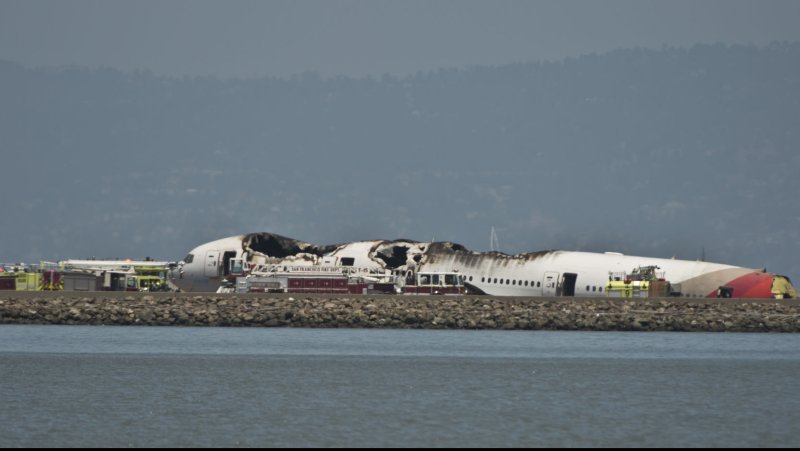1 of 5 | Emergency vehicles surround the remains of an Asiana Air Boeing 777 on the runway at San Francisco International Airport after it crashed on landing in San Francisco on July 6, 2013. The plane was arriving from Seoul. UPI/Terry Schmitt |
License Photo
SAN FRANCISCO, July 7 (UPI) -- Technology that helps pilots approach runways was not working at the time Asiana Airlines Flight 214 crash-landed in San Francisco, FAA officials said Sunday.
Passengers on the plane said it came in too low on its descent to a runway at the San Francisco International Airport Saturday before it slammed into the runway, causing the tail to sever and the rest of the plane to spin on its belly, CNN said.
First responders found the bodies of two 16-year-old Chinese girls on the runway next to the burning wreckage of the Boeing 777-200. Asiana Airlines identified the girls as Wang Linjia and Ye Mengyuan.
The Instrument Landing System -- which was not working at the time of the crash -- normally helps pilots correctly approach runways for landings. Retired pilot Mark Weiss told CNN there are other systems aboard the Boeing 777 aircraft that would also provide similar warnings if a aircraft is coming in too low.
National Transportation Safety Board Chairman Deborah Hersman said pilots are expected to recognize "what's going on" in these types of situations without warning systems.
"So for them to be able to assess what's happening and make the right inputs to make sure they're in a safe situation -- that's what we expect from pilots," she said.
"Stabilized approaches have long been a safety concern for the aviation community," Hersman added. "We see a lot of runway crashes."
Investigators have not determined the cause of the crash, though they haven't ruled out anything, including the possibility of pilot error. The flight recorders from the jetliner, which originated from Seoul, were sent to Washington, D.C., where the NTSB will investigate the cause of the crash alongside Seoul's transportation ministry, Asiana Airlines and Boeing, CNN reported.
There were 305 people on the plane who survived the crash, though 182 were taken to hospitals, 49 of whom had serious injuries.
"We're lucky there hasn't been a greater loss of life," San Francisco Fire Chief Joanne Hayes-White said.
Of the 307 people on board, 141 were Chinese -- including a group of 70 teachers and students who were on their way to a summer camp -- 77 South Koreans, 61 Americans and one Japanese, Asiana Airlines said. The nationalities of the remaining 16 were not identified.
It was not reported if Wang and Ye were traveling as part of the the group of Chinese teachers and students.
In a press conference Sunday, Asiana Airlines President Yoon Yong-doo issued an apology for the crash.
"I sincerely apologize over the accident, and to the passengers on board and their families," he said.
He said the pilot of the flight knew there was a problem and radioed ahead to the control tower at the San Francisco airport to alert emergency crews. There was no emergency in-flight announcement made to passengers before the crash, though, Yonhap News Agency reported.















